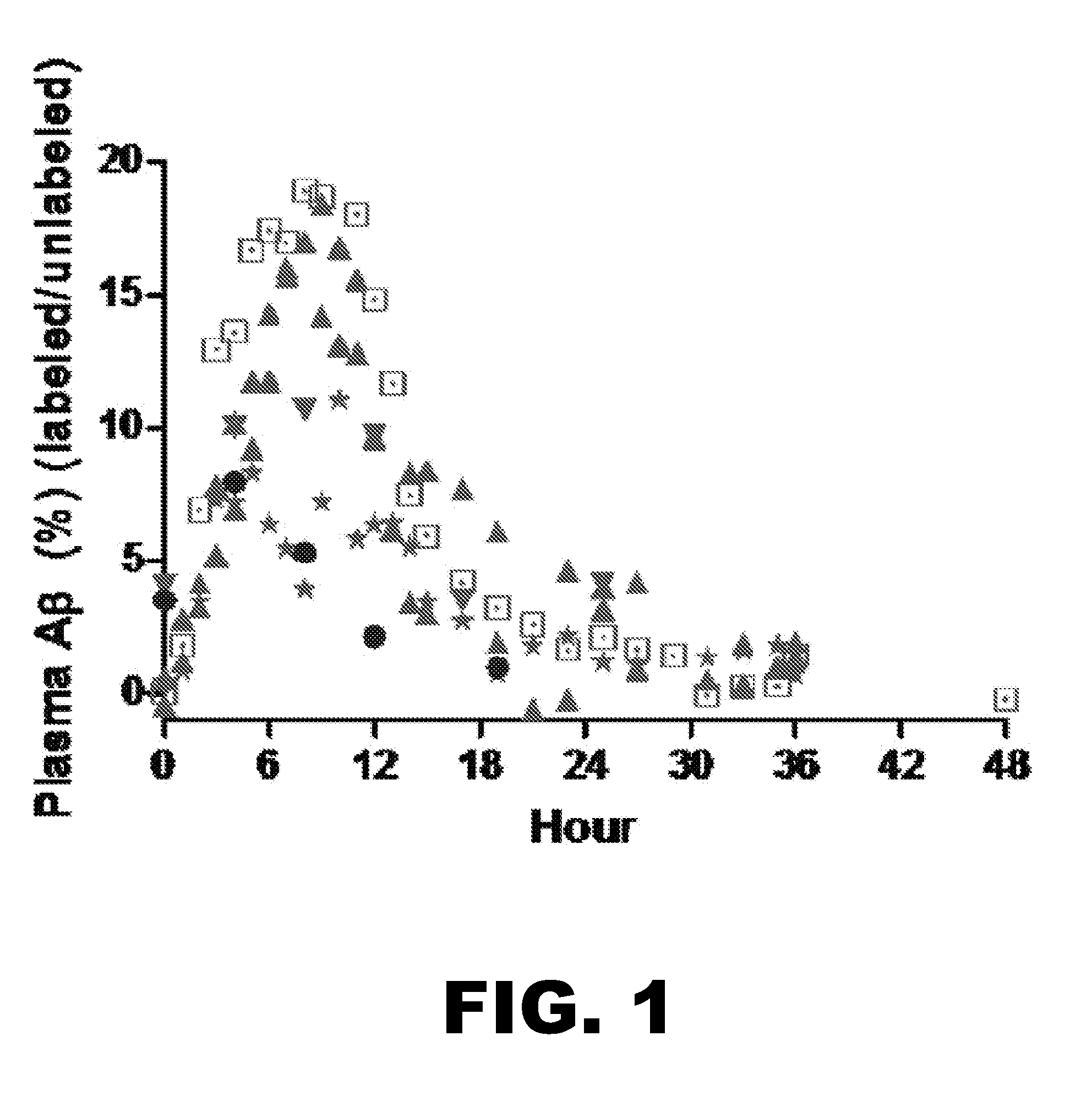Methods for diagnosing alzheimer's disease
a technology for alzheimer's and amyloidosis, applied in the field of amyloidosis diagnosis and treatment, can solve the problems of no disease-modifying treatment, increased public health problems, and heavy personal and financial toll on patients and families
- Summary
- Abstract
- Description
- Claims
- Application Information
AI Technical Summary
Benefits of technology
Problems solved by technology
Method used
Image
Examples
example 1
Aβ Turnover in Blood
[0089]Genetic, biochemical, and animal model studies strongly support the hypothesis that amyloid-β (Aβ) plays a central role in AD: more specifically that accumulation and conformational change of Aβ in toxic forms are major contributors to AD pathogenesis.
[0090]A pioneering approach was recently developed to directly measure Aβ metabolism in the central nervous system of living humans. This method requires participants be admitted to a research hospital room, and have two IV catheters and a lumbar spinal catheter placed so that hourly samples of blood and cerebral-spinal fluid can be obtained. Using this method, recent studies have demonstrated that Aβ has a rapid metabolism (half-life of 8-10 hours) in the human brain and cerebral-spinal fluid (CSF). We have recently measured the dose-related effects of a proposed disease modifying treatment for AD, a gamma-secretase inhibitor, and have demonstrated direct inhibition of the production of Aβ in the human centra...
example 2
Aβ Blood Kinetics
[0109]In order to determine blood Aβ kinetics, a method was developed to measure 13C6-leucine labeled Aβ in plasma. Prior studies in animal models demonstrate faster Aβ turnover in the periphery compared to the CNS. The new method required a state-of-the-art mass spectrometer with levels of quantitation in the low attomole (10−18) range. The first measurements of blood Aβ kinetics are shown compared to CSF Aβ kinetics in FIG. 3.
[0110]These results demonstrate blood Aβ kinetics are distinct from CNS Aβ kinetics and can be utilized in multi-compartment models to calculate the rates of formation, transport, and breakdown of Aβ both in the CNS and body.
[0111]In order to compare the kinetics of blood Aβ in AD versus controls, we measured labeled plasma Aβ in blood samples from 12AD and 8 control participants and compared as shown in FIG. 4.
[0112]In order to provide key additional kinetic information on blood Aβ kinetics which has a much faster turnover rate, and to poten...
example 3
REFERENCES FOR EXAMPLE 3
[0126]1. J. Hardy, D. J. Selkoe, The amyloid hypothesis of Alzheimer's disease: Progress and problems on the road to therapeutics. Science 297, 353 (2002).[0127]2. J. L. Cummings, Alzheimer's disease. N. Engl. J. Med. 351, 56 (2004).[0128]3. D. Scheuner et al., Secreted amyloid beta-protein similar to that in the senile plaques of Alzheimer's disease is increased in vivo by the presenilin 1 and 2 and APP mutations linked to familial Alzheimer's disease. Nat. Med. 2, 864 (1996).[0129]4. R. J. Bateman et al., Human amyloid-beta synthesis and clearance rates as measured in cerebrospinal fluid in vivo. Nat. Med. 12, 856 (2006).[0130]5. R. J. Bateman et al., A gamma-secretase inhibitor decreases amyloid-beta production in the central nervous system. Ann. Neurol. 66, 48 (2009).[0131]6 R. B. DeMattos et al., ApoE and clusterin cooperatively suppress Abeta levels and deposition: evidence that ApoE regulates extracellular Abeta metabolism in vivo. Neuron 41, 193 (2004...
PUM
 Login to View More
Login to View More Abstract
Description
Claims
Application Information
 Login to View More
Login to View More - R&D
- Intellectual Property
- Life Sciences
- Materials
- Tech Scout
- Unparalleled Data Quality
- Higher Quality Content
- 60% Fewer Hallucinations
Browse by: Latest US Patents, China's latest patents, Technical Efficacy Thesaurus, Application Domain, Technology Topic, Popular Technical Reports.
© 2025 PatSnap. All rights reserved.Legal|Privacy policy|Modern Slavery Act Transparency Statement|Sitemap|About US| Contact US: help@patsnap.com



